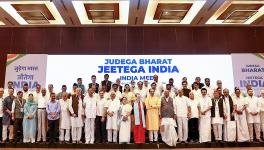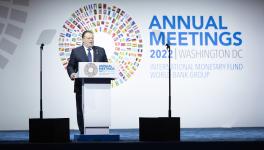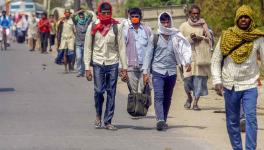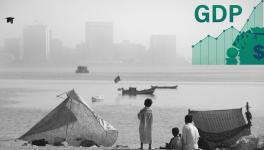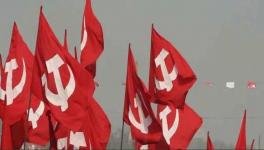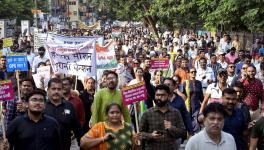Union Budget Priorities and ‘Otherising’ of Oppressed Communities
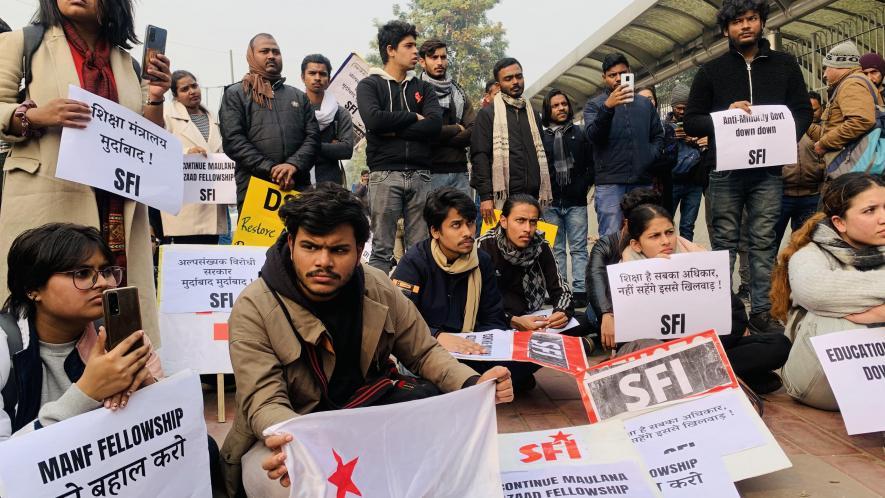
Students organisations protest against the discontinuation of Maulana Azad National Fellowship in Delhi. (File Photo)
The Union budget presented by the Central government in 2023 is unusual. In spite of it being presented in a pre-election year, the Centre does not seem to collect and allocate resources to further either social welfare or productive investment. How is this “paradox” to be accounted for? Not unexpectedly, the Central government and its supporters do claim that its budget does advance both objectives but such claims are contradicted by the budget numbers.
Let us, therefore, prior to examining possible causes of this “paradox”, synoptically examine some of the proposed changes in the Union budget. Many welfare schemes, such as the Mahatma Gandhi National Rural Employment Guarantee Scheme, National Livelihood Mission—Ajeevika, PM Kisan Samman Nidhi (PM-KISAN), PM Krishi Sinchai Yojana, National Social Assistance Programme, Market Intervention Scheme (to support agricultural procurement) and umbrella programme for development of minorities have seen cuts in allocation of varying magnitudes. Besides, there have been cuts in fertiliser subsidies and food subsidies (including those for decentralised procurement of foodgrains).
As far as other items of public expenditure are concerned, the allocations for the Integrated Child Development Scheme, the umbrella programme for the development of Scheduled Castes/dalits and Scheduled Tribes have seen meagre nominal increases in budget allocation. But the inflation rate in the next financial year is likely to be high enough to result in allocations to these three schemes falling in real terms. In the case of the PM Poshan Shakti Nirman (Mid Day Meal programme), the allocation has risen compared with last year’s budget estimates, but has fallen relative to revised estimates of last year.
Another well-worn tactic of the Union government is to launch new schemes, such as PM Particularly Vulnerable Tribal Groups Development Mission or PM Vishwakarma Kaushal Samman for people belonging to the oppressed communities, while cutting aggregate allocations (in real terms) for schemes meant for these very communities.
Besides, the Union government has cut allocations to state governments. This has worsened the mismatch between state governments’ role as the principal vehicle of public spending and their declining share of resources (vis-a-vis the Centre). Previously, the introduction of the goods and services tax has furthered the ability of the Central government to undermine federalism. Under these circumstances, it is not inconceivable that the ability of state governments to undertake both capital and revenue expenditures would tend to be undermined.
The Central government in its budget has made much of its ostensible plans to increase public capital expenditure to Rs. 10 lakh crore. But a number of questions remain both at the empirical (including regarding the nature of that proposed capital expenditure) and theoretical level. Let us briefly summarise these concerns.
First, a part of the increase in government capital expenditure has been matched by an equivalent fall in capital expenditure by public sector undertakings. Second, government support to oil companies has been misrepresented as public capital expenditure to further a green transition. Third, the allocation to states for 50-year loans might not involve any net increase in public capital expenditure but merely a resourcing of funding for existing public capital expenditure. Besides, the conditions for the utilisation of these loans by state government are arduous, especially in the light of the cut in aggregate support to state governments (and particularly for relatively more resource constrained state governments).
Fourth, allocations to Bharat Sanchar Nigam Limited and Bharat Petroleum Limited may not necessarily be used for capital expenditure given the bottom-lines of these companies. Fifth, allocation to the Railways for public capital expenditure may remain at least partly unutilised and may partly be used for unproductive vanity purposes such as creation of gentrified enclaves in railway stations.
Sixth, the meagre allocation for public capital expenditure in agriculture has either been cut or has stagnated or past allocations in this regard have at least partly remained unutilised. Lastly, it is arguable that a certain fraction of public capital expenditure is meant to shore up the bottomlines of those segments of big capital that are entrenched in the infrastructural sector and are proximal to the neo-fascist dispensation.
Besides these empirical considerations, there are also theoretical considerations that militate against this ostensible strategy of reducing social sector expenditure while supposedly increasing public capital expenditure of which we mention three. First, if it is plausibly assumed that labour productivity in activities involving social welfare is lower than in those involving public capital expenditure then a rise in the latter matched by a fall in the former is not likely to have a positive impact on aggregate employment.
Second, if it is believably presumed that public capital expenditure involves activities that are more import intensive than those involving the social sector then the resulting demand driven increase in output will be lower if public capital expenditure rises at the expense of social sector expenditure. Third, if there are significant gestation lags in the construction projects initiated by a rise public capital expenditure matched by a cut in social sector expenditure then that would have stagnationary consequences. The latter would transpire since the anticipated crowding in of private investment by public investment would be delayed while the impact of demand compression due to the cut in social sector expenditure would be felt immediately. The decline in private investment as a proportion of gross domestic product last year seems to indicate that such theoretical considerations are not without empirical relevance.
The Union government seeks to make the case for the alleged merits of an ostensible rise in public capital expenditure at the expense of a cut in social sector expenditure since it is firm on its quest for fiscal “prudence”. A fundamental factor underlying this quest for fiscal “prudence” is the hegemony of the neoliberal project in India. In the absence of effective capital controls, the Union government has to cut public expenditure (directed toward the working people) in order to gain the confidence of international finance.
The other means to attain fiscal “prudence” by enhancing taxes on elites (corporate taxes, wealth taxes, inheritance taxes, capital gains taxes etc.) is not acceptable to international finance (and the domestic corporate-financial oligarchy). Besides, it cannot be ruled out that some policy makers fallaciously believe that fiscal “prudence” has a valid macroeconomic rationale.
However, this fiscal “prudence” does not identically impinge on all the people. At one level, it is transparently policy-driven. For instance, there seems to be a deliberate attempt to single out minorities (especially Muslims) by cutting the allocation for the umbrella programme for development while ostensibly increasing those intended for Scheduled Castes/dalits and Scheduled Tribes but in fact cutting allocations for all three communities in real terms (but at different rates). Further, there has been a small cut in income taxes to be paid by the salaried that has been accompanied by a wide ranging cut in social sector expenditure.
In other cases, the transmission of the impact of changes in public expenditure and taxation tends to have a differential and disproportionate social impact. For instance, a cut in the budget for public health in real terms does not imply that this cut will be proportionally transmitted across different classes, different segments of the working people or across various regions in India.
Let us examine in a stylised manner, the process of social transmission of a cut in the Union budget allocation for public health. To begin with, the elites get their healthcare in private hospitals (both in India and in the developed countries) and hence their ability to meet their healthcare needs is unaffected by a cut in the Union budget allocation for public health.
Among the working people, such a cut in the Union budget allocation for public health is likely to impinge disproportionately on those living outside big cities and on those from oppressed communities. For instance, an increase in waiting time to obtain healthcare in public health centres in such cases is “plausibly” attributed to local corruption or inefficiencies. While the latter is a proximate determinant of the diminishing healthcare provision, the disproportionate focus on local corruption or inefficiencies (by the propaganda apparatuses of the neoliberal project) is a deliberate expedient to divert attention from the macroeconomic reality of the cut in the Union budget allocation for public health. Thereby they seek to insulate the neoliberal project from its necessary consequences.
Further, a cut in the Union budget allocation for public health is transmitted disproportionately on oppressed communities that are compelled to cluster together on account of (policy linked) segregation (such as tribals, Muslims or dalits). The neo-fascist forces then seek to portray this state of affairs as “legitimate” comeuppance (ostensibly on account of the reluctance of these marginalised communities to integrate themselves into the “mainstream” as supplicant mendicants).
Even if the Union government of India is using the budget to further its offensive on the working people (that is disproportionately impacting the most oppressed), why aren’t (most) opposition parties not exerting their political-organisational energies in resisting these neoliberal policies? This is principally on account of the incorporation of these mainstream Opposition parties into the neoliberal project. Consequently, while they differ with the neo-fascist forces on the timing, sequencing, pacing and sharing of “spoils” of neoliberal exercises, such as “fiscal prudence”, they do not significantly differ about the direction of such policies. The tokenist nature of the critique of the Union budget by mainstream opposition parties (that often but not always critiques the consequences of neoliberal policies) adds to the propaganda heft of the neo-fascist forces about their budget-making process (especially as regards their ostensible intent).
Significantly, this pusillanimity of the mainstream opposition parties is conducive to the generation of “conducive” expectations among some segments of the working people about “feasible” policies in the current conjuncture. This often tends to result in alternatives to neoliberal policies failing to gain adequate political traction. Needless to say, the mainstream media is also complicit in seeking to discredit any alternatives to neoliberal policies.
By failing to effectively critique neoliberal policies, mainstream opposition parties create conditions that are non-conducive to resisting the neo-fascist forces. Instead, their critique of the neo-fascist forces tends to be centred on the foibles of the leadership of the neo-fascist forces. This allows the neo-fascist forces to regurgitate their time-tested tactic of otherising oppressed communities (such as Indian Muslims). In fact, some denizens of the neo-fascist forces have sought to explicitly counter-pose (the deleterious impact of) neoliberal policies to the ostensible consequences of otherised communities getting “out of hand”. In effect, such denizens of the neo-fascist forces are seeking to make the case that neoliberal policies are the “lesser evil”.
The presentation of the Union budget in 2023 has coincided with a serious crisis confronting the Adani Group. The Hindenburg Research report on the Adani Group has triggered a sharp decline in its market capitalisation. This is bound firstly, to have negative financial implications both domestically (principally on public sector financial institutions) and abroad (through balance of payments implications involving principally the state of confidence of international finance). Further, the crisis confronting the Adani Group could have deleterious consequences involving both forward and backward linkages with the rest of the domestic economy (as well with other countries). Evidently, such a crisis could also impact the implementation of the Union budget.
The opposition parties are demanding an enquiry by a joint parliamentary committee into the happenings around the Adani Group. Given the widely talked about proximity of the head of this conglomerate to the leadership of the neo-fascist dispensation, the demand for an enquiry based on a joint parliamentary committee will have more credibility. Such an enquiry could go some way to both recover both the integrity of the budget-making process and restore the congruence between the rhetoric and actual impact of the budget (through supplementary budget-related measures for instance). It could also act as a trigger to mobilise a more unified, broad-based and, therefore, meaningful challenge to the neo-fascist dispensation.
The writer is professor, department of economics, Satyawati College, University of Delhi. The views are personal.
Get the latest reports & analysis with people's perspective on Protests, movements & deep analytical videos, discussions of the current affairs in your Telegram app. Subscribe to NewsClick's Telegram channel & get Real-Time updates on stories, as they get published on our website.










